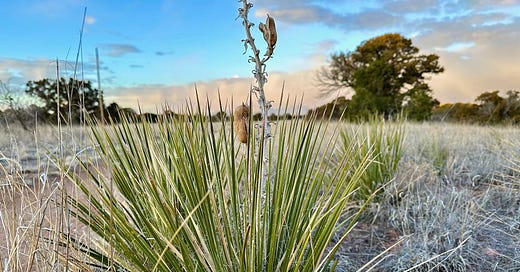don’t mess with me! say skin-piercing yucca leaves tender green with spring
Yucca intermedia, the yucca that grows throughout the shortgrass prairie where I live, sports spiky defenses, each leaf tipped with a stout, needle-sharp awl that can in fact pierce skin. Yet it greens up long before everything else, a welcome sign of spring.
Good morning, Friends! It’s Wednesday and time to flex our gratitude muscles, whether we think we have anything to be grateful for or not. It turns out that just the exercise of thinking about being grateful can lift our moods and engage the part of our brains where empathy and lovingkindness live.
What are you grateful for today? Hit the comment button to share if you choose.
This morning, I woke grumpy and tired, feeling the long-term exhaustion of the last 20 years of caregiving, tending the dying in my family, scrabbling to get out of debt and searching for a place to call home. I set out for my dawn walk not feeling thankful at all. Then as the sun rose, highlighting the green clumps of yucca in the still winter-bleached prairie, I suddenly thought, I am grateful for yucca.
Which made me laugh, because these ground-hugging plants are more Dr. Seussian than beautiful, but they also give a taste of spring before most other plants. Those awl-tipped leaves are evergreen, photosynthesizing on warm days throughout winter, and then, as the days lengthen, the rosette of leaves turns more intensely green, a welcome sign in dusty late winter days.
Like many high-desert plants, intermediate yucca is a model of resilience and adaptation to an environment where water is almost always in short supply. The above-ground plant is no more than three or four feet tall, even with the flower stalk that appears in May and June bearing waxy, ivory flowers that droop like so many bells.
Underground, in the more clement environment below the surface, this yucca grows a many-foot-long tap root which stores sugar and water, connected to a network of surface roots that can harvest moisture from even the lightest of rains. The combination allows yucca plants to thrive through months with no rain by sipping the underground stores, something we water-wasting humans could use to emulate.
First Peoples have pounded yucca roots into shampoos and hair treatments for millennia. In Common Southwestern Native Plants (3rd edition) authors Jack and Martha Carter, Donna J. Stevens and Jennifer Bousselot say the root solution of plains yucca was used to kill head lice and stimulate hair growth. We forget that plants were our first medicines; that drugstore is still all around us in our green kin.
Yucca flower stalks look something like giant asparagus before the buds swell and the flowers open, and in fact, both stalks and buds and flowers are edible, either raw or cooked.
The leaves are edible too, at least if you are a pack rat with chisel-like teeth and internal microbes to digest the cellulose that gives them stiffness and structure.
People have long used the leaves for their fiber, chewing them to make them soft and then weaving them into baskets and cords used for all manner of things, from hunting snares to sandals. The oldest yucca-fiber sandals in the American Southwest have been radio-carbon dated to 8,000 years ago!
Intermediate yucca and yucca species in general—there are more than a dozen species throughout the North American deserts and western Great Plains—have a tight and mutually beneficial relationship with a group of small, gray-brown moths called Pronuba moths.
The video below, which is from my Weekly Wildflower series, explains how the moths and plants benefit each other through pollination and food for the moth larvae. (Sound up!)
The more I learn of yucca’s stories and life, the more I am grateful for this resilient and creative plant, which thrives despite long droughts, and provides food, medicine, fiber and beauty to these magical desert landscapes.






Gratitude is medicine for the soul.
I enjoy your gratitude letter each week. I practice a regular daily and sometimes hourly gratitude prayer. I don't even think about it, it just bubbles up. Something I've developed in the last 10 years. That said, I always appreciate a reminder and especially a reminder to appreciate the simple and sometimes small things in our lives. Especially realizing they are not small and as you explained with the yucca, some things have been around for human use and benefit for millennia!
Last week one gratitude prayer was for the morning birds in my yard. There were so many and I also appreciated the app I used on my ipad to identify them. That's when I appreciate mobile technology! This morning it is the ability to use self clean on my oven! And this week it was also for the lovely people who finished my home restoration project with the new gutters. A roof, house washing and trim painting, and finally the gutters have given my home a wonderful tidiness and is protecting this asset that is important to my overall wellbeing, not just financial.
And I appreciate what you have taught me about writing, as this week I was able to write about fear and hope and the roller coaster it can create in our lives and has created in mine. This writing was part of a healing process and I am so grateful I have this tool as a way to heal. It helps bring awareness of emotions that can stay buried. Writing brings things up for clarity, healing, and letting go. So much to be grateful for every single day! Thank you for the place to express my gratitude in 'public'. Much love to you dear Susan and all you bring to us in this lovely newsletter.